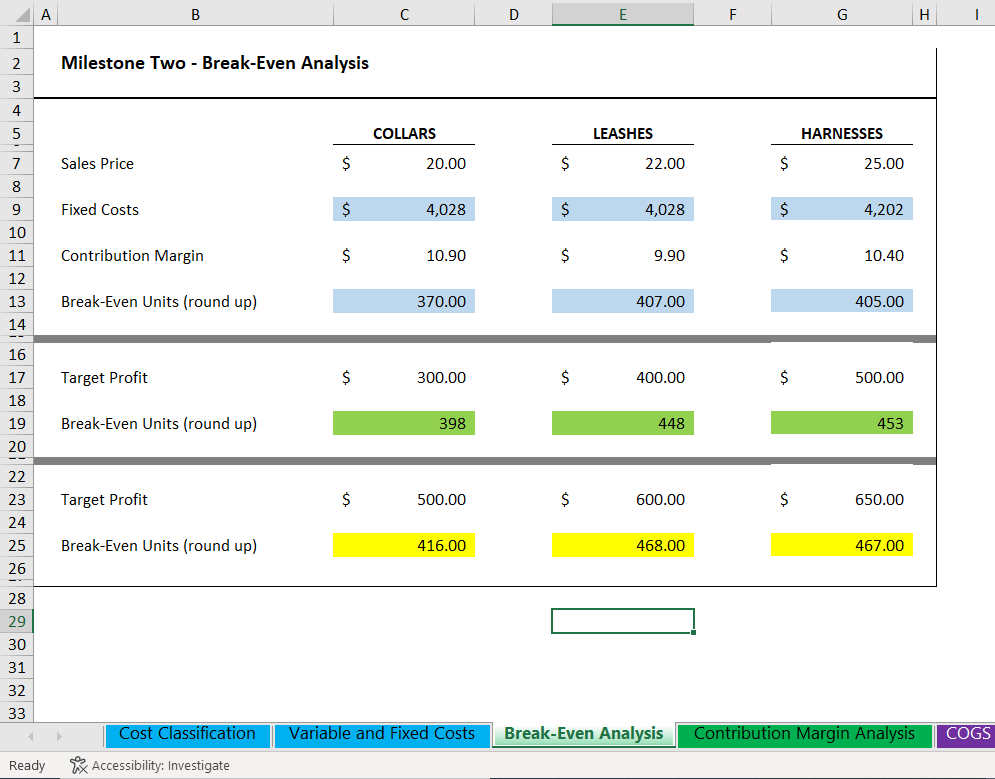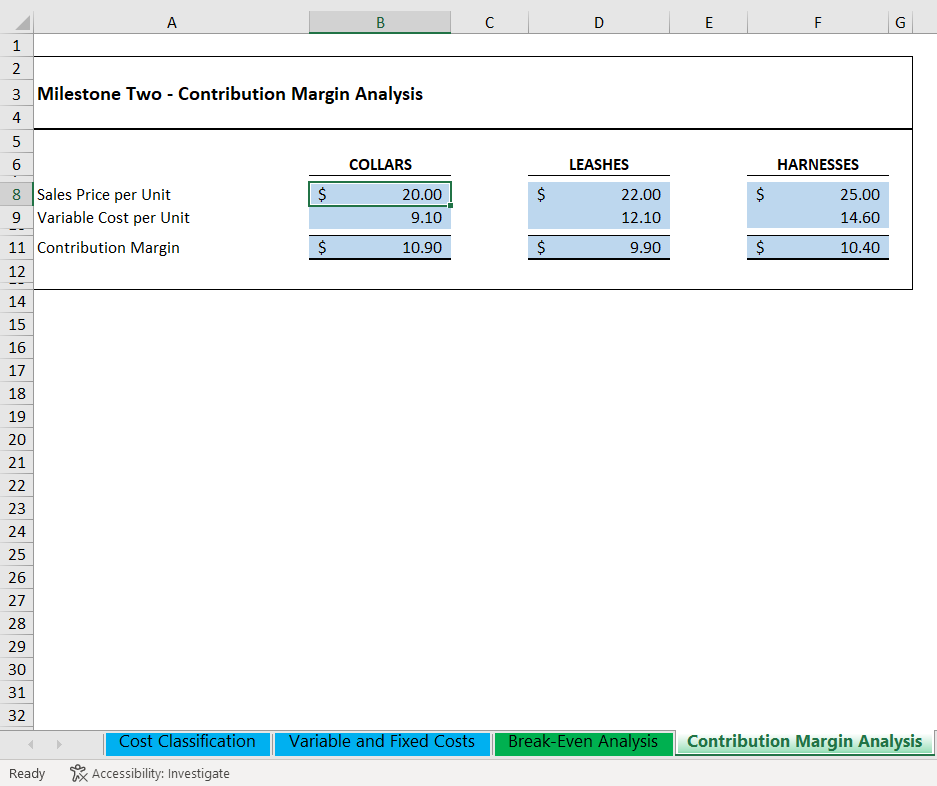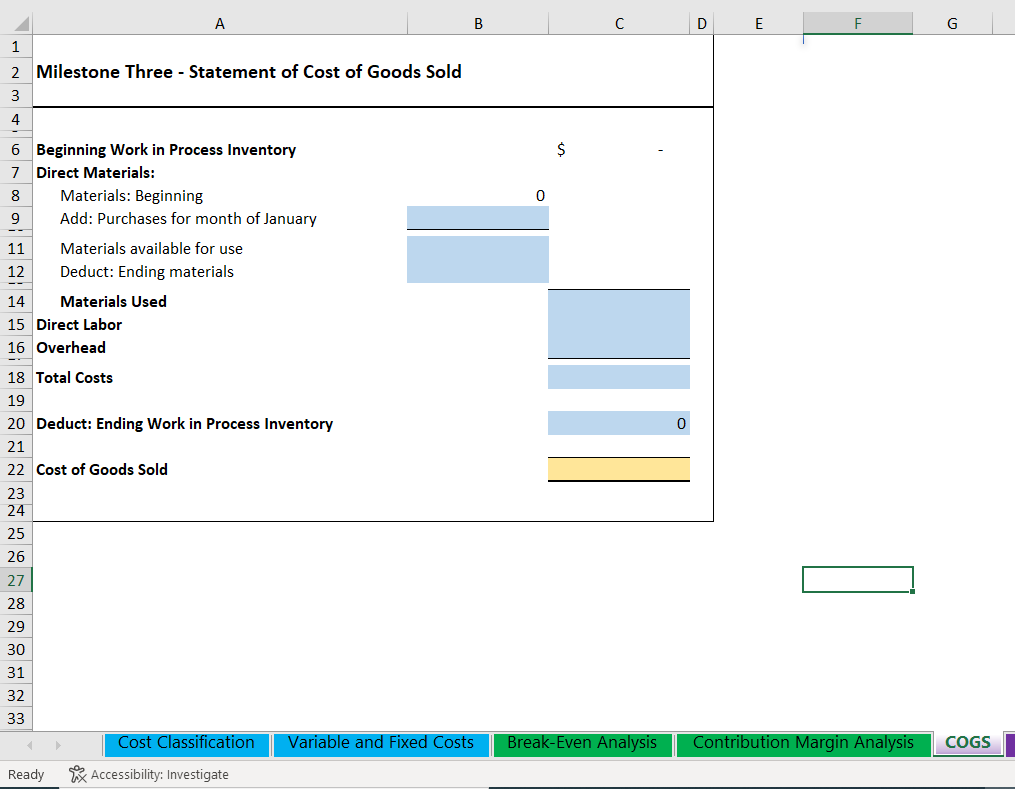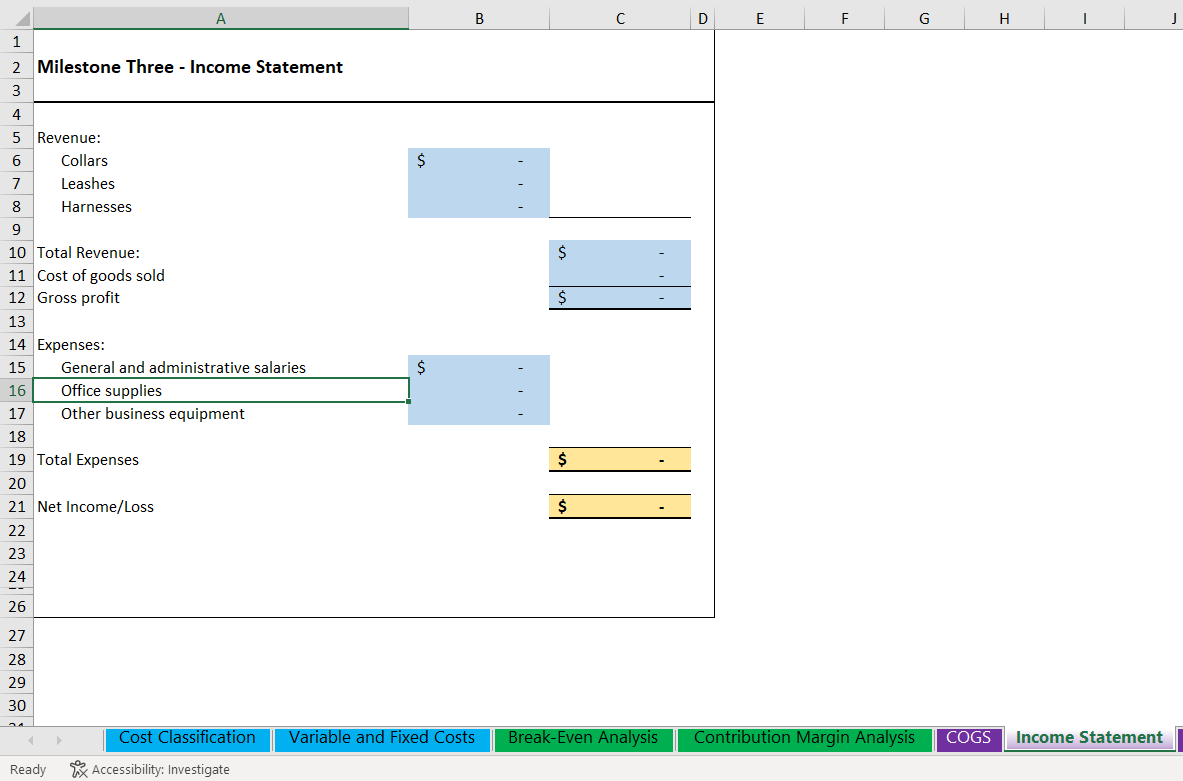


ACC 202 Milestone Three: Actual Costs and Revenue Data Appendix
At the end of the first month of opening your business, you calculate the actual operating costs of the business and the income you earned. You also notice and document the difference in what you budgeted for certain materials and labor against the actual amounts you spent on the same.
For your statement of cost of goods sold, use the following data regarding the actual costs incurred by the business over the past month:
- Materials purchased: $20,000
- Consumed 80% of the purchased materials
- Direct labor: $8,493
- Overhead costs: $3,765
Note: Assume that the beginning materials and ending work in process are zero for the month.
Use the following revenue and cost information for the income statement. Note that the revenue you use will depend on the pricing level options you chose in Milestone Two. Also, assume that after accounting for weekends and other holidays, there were 20 business days in the first month of operation. For example, if you chose a sales price of $20 per collar, the actual number of collars sold in the month was 33 per day or 33 x 20 = 660 per month.
The other costs incurred by the business include:
- General and administrative salaries
- Office supplies: $200
- Other business equipment: $150
Variance
At the end of the month, you find that the labor and materials spent on manufacturing collars was different from what you estimated:
- The collar maker had to work nine hours a day instead of eight due to an increased demand for collars.
- Because of the increased demand, the hourly rate you paid your employee for making the collars increased to $16.50.
- An increase in the cost of raw material led the direct material cost per collar to increase to $10.
- However, you also made and sold 60 more collars than you expected to sell in the month.
You now need to determine the variance in the materials and labor cost from what you estimated in Milestone Two based on the market
I need to answer the following and show my work can you please assist?



A B 1 2 Milestone One - Variable and Fixed Costs 3 4 5 Collars 7 Item 9 High-tensile strength nylon webbing $ 10 Polyesterylon ribbons 11 Buckles made of cast hardware 12 Price tags $ 13 14 15 16 17 1.9 Total Variable Costs per Coll $ 20 22 23 Leashes 25 Item 27 High-tensile strength nylon webbing $ 28 Polyesterylon ribbons $ 29 Buckles made of cast hardware 30 Price tags $ 31 32 33 34 35 36 38 Total Variable Costs per Lea_$ 39 39 41 42 Harnesses 44 Item 46 High-tensile strength nylon webbing $ 47 Polyesterylon ribbons $ 48 Buckles made of cast hardware $ 49 Price tags $ 50 51 52 53 54 55 57 Total Variable Costs per Har $ 58 Ready ariable Cost/ltem 4.00 3.00 2.00 0.10 9.10 ariable Costiltem 6.00 4.50 1.50 0.10 12.10 ariable Cost/ltem 6.00 4.50 4.00 0.10 14.60 Cost Classification 2. Accessibility: Good to go C Variable and Fixed Costs D Item Collar maker's salary (monthly) Depreciation on sewing machines Rent Utilities and insurance Scissors, thread, and cording Loan payment Salary to self Total Fixed Costs $ 4,028.33 Item Fixed Costs $ 2,773.33 Leash maker's salary (monthly) Depreciation on sewing machines Rent $ 55.00 $ Utilities and insurance $ 250.00 200.00 400.00 Scissors, thread, and cording $ Loan payment $ 183.33 Salary to self $ 166.67 Total Fixed Costs $ 4,028.33 Item Fixed Costs Harness maker's salary $ 2,946.67 55.00 Depreciation on sewing machines $ Rent $ 250.00 Utilities and insurance $ 200.00 $ 400.00 Scissors, thread, and cording Loan Salary to self $ 183.33 166.67 $ Total Fixed Costs $ 4,201.67 Break-Even Analysis Contribution Margin Analysis E Fixed Costs $ $ 2,773.33 55.00 250.00 200.00 $ $ $ $ 400.00 183.33 166.67 $ F G H 55 ####### I J K L M N COGS Income Statement 0 P Variances A B Milestone Two - Break-Even Analysis Sales Price Fixed Costs Contribution Margin Break-Even Units (round up) Target Profit Break-Even Units (round up) Target Profit Break-Even Units (round up) 1 2 3 4 5 7 8 9 10 11 12 13 14 16 17 18 19 20 22 23 24 25 26 28 29 30 31 32 33 Ready $ $ COLLARS $ $ D 20.00 22.00 4,028 4,028 10.90 9.90 370.00 407.00 300.00 400.00 398 448 500.00 600.00 416.00 468.00 Cost Classification Variable and Fixed Costs Break-Even Analysis Accessibility: Investigate E LEASHES $ $ $ $ $ $ $ $ G HARNESSES H 25.00 4,202 10.40 405.00 500.00 453 650.00 467.00 Contribution Margin Analysis I COGS A B 2 3 Milestone Two - Contribution Margin Analysis 4 5 6 COLLARS 8 Sales Price per Unit 9 Variable Cost per Unit 11 Contribution Margin 12 14 15 16 17 1 NT 18 19 20 21 22 23 24 25 26 27 28 29 30 31 32 Ready Cost Classification Accessibility: Investigate $ 20.00 9.10 $ 10.90 Variable and Fixed Costs D LEASHES E F HARNESSES (5) G $ 22.00 $ 25.00 12.10 14.60 $ 9.90 $ 10.40 Break-Even Analysis Contribution Margin Analysis A B 1 2 Milestone Three - Statement of Cost of Goods Sold 3 4 6 Beginning Work in Process Inventory 7 Direct Materials: 8 Materials: Beginning 9 Add: Purchases for month of January 11 Materials available for use 12 Deduct: Ending materials 14 Materials Used 15 Direct Labor 16 Overhead 18 Total Costs 19 20 Deduct: Ending Work in Process Inventory 21 22 Cost of Goods Sold 23 24 25 26 27 28 29 30 31 32 33 Ready Cost Classification F G Variable and Fixed Costs Break-Even Analysis Contribution Margin Analysis COGS Accessibility: Investigate 0 $ D E A 1 2 Milestone Three - Income Statement 3 4 5 Revenue: 6 Collars 7 Leashes 8 Harnesses 9 10 Total Revenue: 11 Cost of goods sold 12 Gross profit 13 14 Expenses: 15 General and administrative salaries 16 Office supplies 17 Other business equipment 18 19 Total Expenses 20 21 Net Income/Loss 22 23 24 26 27 28 29 30 Ready Cost Classification Accessibility: Investigate $ $ B Variable and Fixed Costs $ $ $ $ Break-Even Analysis D G Contribution Margin Analysis E F H | J COGS Income Statement A B 1 2 Milestone Three - Variance Arlalysis 3 4 5 Data for Variance Analysis: Budgeted (Standard) Hours/Qty 6 7 8 Labor 9 10 11 Materials 12 13 14 15 Variances for Collar Sales 16 17 Direct Labor Time Variance 18 (Actual Hours - Standard Hours) x Standard Rate 19 20 Direct Labor Rate Variance 21 (Actual Rate - Standard Rate) x Actual Hours 22 23 Direct Materials Quantity/Efficiency Variance 24 (Actual Quantity - Standard Quantity) x Standard Price 25 26 Direct Materials Price Variance 27 (Actual Price - Standard Price) x Actual Quantity 28 29 30 Cost Classification Ready Accessibility: Investigate Budgeted (Standard) Rate Variable and Fixed Costs D Actual Hours/Qty Variance $ $ $ $ Break-Even Analysis E Actual Rate Favorable/ Unfavorable F G H Contribution Margin Analysis K COGS Income Statement L M Variances












